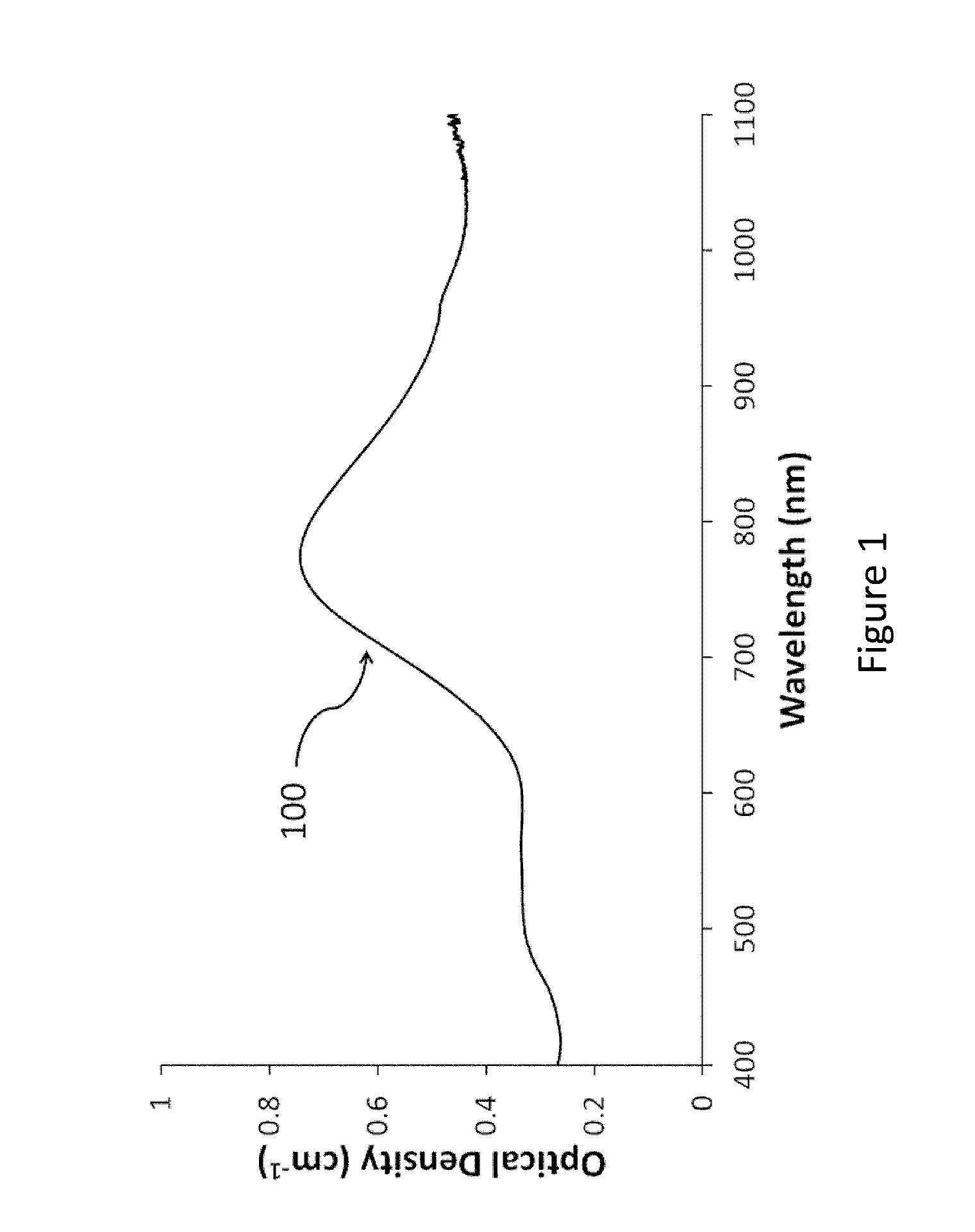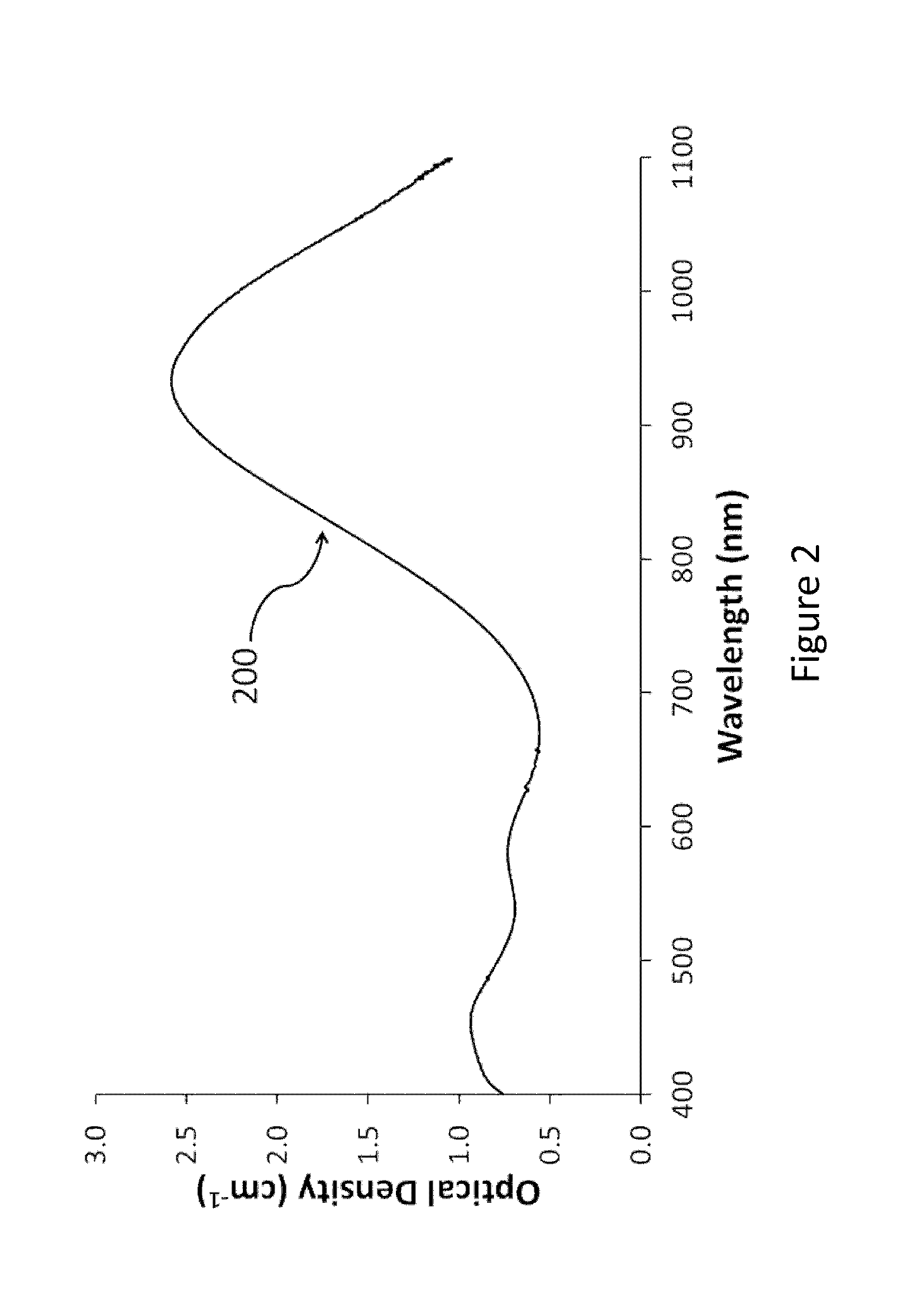Silver nanoplate compositions and methods
a silver nanoplate and composition technology, applied in the field of silver nanoplate compositions and methods, can solve the problems of unsatisfactory degradation of the optical properties of nanoparticles, and achieve the effects of reducing the degradation of the optical properties of silver nanoplates, increasing optical density, and high optical density
- Summary
- Abstract
- Description
- Claims
- Application Information
AI Technical Summary
Benefits of technology
Problems solved by technology
Method used
Image
Examples
example 1
Silver Nanoplates
[0091]Silver nanoplates were synthesized using silver seeds prepared through the reduction of silver nitrate with sodium borohydride in the presence of sodium citrate tribasic and poly sodium styrene sulfonate under aqueous conditions. Silver seed preparation: 21.3 mL of an aqueous 2.5 mM sodium citrate tribasic solution was allowed to mix under magnetic stirring. 1 mL of a 2 g / L poly styrene sodium sulfonate (PSSS) solution was then prepared in a separate beaker. 21.3 mL of a 0.5 mM silver nitrate solution was then prepared by dissolving the salt in water. Once the above solutions have been prepared, 1.33 mL of a 0.5 mM sodium borohydride solution was prepared in 4° C. water. The borohydride and PSSS solutions were then added to the beaker containing the citrate and allowed to mix. The silver nitrate solution was then pumped into the citrate solution using a peristaltic pump at a rate of 100 mL / min. This seed solution was then allowed to stir overnight at room temp...
example 2
Concentrated Silver Nanoplates
[0092]15 L of silver nanoplates with a peak optical density of about 5 cm−1 were mixed with 3.5 g of polyvinylalcohol (PVA) and sodium borate, concentrated using tangential flow filtration using a 500 kD polysulfone tangential flow membrane with 3100 cm2 of surface area. The solution was concentrated for approximately 90 minutes, and the final solution volume was reduced from 15 L to 0.5 L. The silver nanoplate solution optical density was increase to about 150 cm−1. Thus, according to one embodiment, a method for increasing a silver nanoplate solution from 5 cm−1 to 150 cm−1 (e.g., an increase of roughly 30 times the optical density) comprises the steps of adding PVA and sodium borate to silver nanoplates, and concentrating the solution with tangential flow filtration.
example 3
Concentrated Silver Nanoplates
[0093]In one example of concentrating silver nanoplates, 1.2 L of silver nanoplates with a peak optical density of about 4 cm−1 were mixed with 4 L of anhydrous ethanol and about 49 mL of ammonium hydroxide solution. 0.6 mL of a dilute aminopropyltriethoxysilane (APTES) was added to the solution. After 15 minutes of incubation, 6.5 mL of tetraethylorthosilicate (TEOS) solution was added. After 24 hours 1 L of the solution was concentrated using a 500 kD polysulfone tangential flow membrane with 1050 cm2 of surface area. The final solution volume was decreased to 150 mL, increasing the silver nanoparticle solution optical density to about 40 cm−1. Thus, according to one embodiment, a method for increasing a silver nanoplate solution from 4 cm−1 to 40 cm−1 (e.g., an increase of roughly 10 times the optical density) comprises the steps of adding anhydrous ethanol, ammonium hydroxide solution, aminopropyltriethoxysilane (APTES), and tetraethylorthosilicate ...
PUM
| Property | Measurement | Unit |
|---|---|---|
| second wavelength | aaaaa | aaaaa |
| second wavelength | aaaaa | aaaaa |
| molecular weight | aaaaa | aaaaa |
Abstract
Description
Claims
Application Information
 Login to View More
Login to View More - R&D
- Intellectual Property
- Life Sciences
- Materials
- Tech Scout
- Unparalleled Data Quality
- Higher Quality Content
- 60% Fewer Hallucinations
Browse by: Latest US Patents, China's latest patents, Technical Efficacy Thesaurus, Application Domain, Technology Topic, Popular Technical Reports.
© 2025 PatSnap. All rights reserved.Legal|Privacy policy|Modern Slavery Act Transparency Statement|Sitemap|About US| Contact US: help@patsnap.com



